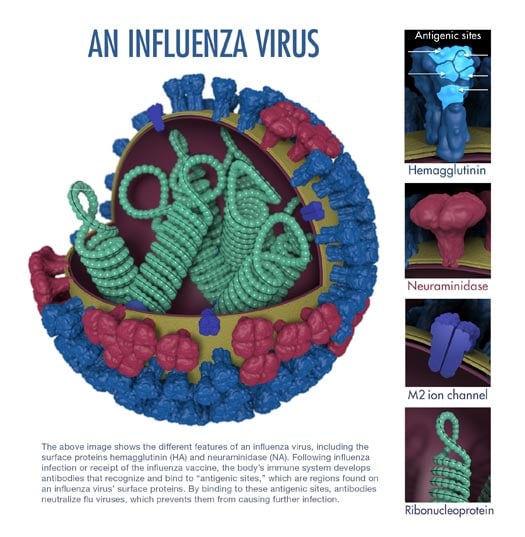VB News Desk: Facts About the Flu
Posted on 10/15/19 by Laura Snider
Here in North America, October through May is flu season. If you’ve ever had the flu, you know firsthand how unpleasant it can be—aches, fever, chills, a runny nose. Yuck.
For most of us, a few miserable days is all we have to go through, but the flu can be life-threatening for populations such as the elderly, young children, and people with certain chronic illnesses.
Fortunately, there’s a lot we can do as a society to help prevent the spread of this disease, from remembering to wash our hands and cover coughs and sneezes to heading to a doctor’s office or pharmacy to get a flu shot.
So here are five facts about the viruses that cause the flu, how it spreads, and what we can do to keep it in check.
1. Seasonal flu is caused by Influenza A and B viruses.
Though we talk about the flu as if it’s just one virus, it is actually caused by several different types and subtypes of influenza viruses. Technically, there are A, B, C, and D types of influenza, but the A and B types are the ones responsible for the seasonal flu. Influenza C generally causes only mild respiratory symptoms, and influenza D viruses affect cows rather than people.
Influenza A viruses are divided into subtypes based on the hemagglutinin (H) and neuraminidase (N) proteins found on their surface. The two influenza A subtypes we usually see in humans are influenza A (H1N1) and influenza A (H3N2). You may remember the swine flu pandemic in 2009. The swine flu was a new influenza A (H1N1) virus that hadn’t previously been seen in humans. “2009 H1N1” has since joined the ranks of human flu viruses.
 Illustration of an influenza virus and its surface proteins. Image courtesy of cdc.gov.
Illustration of an influenza virus and its surface proteins. Image courtesy of cdc.gov.
Influenza B viruses don’t have the subtypes that the A viruses do, but they do have lineages and strains. The influenza B viruses that are currently circulating belong to either the B/Yamagata or B/Victoria lineage.
2. You're most contagious three to four days after symptoms appear.
Someone with the flu can be contagious from 1 day before symptoms appear to 5–7 days after symptoms begin. Children can remain contagious even longer.
When someone with the flu coughs, sneezes, or even speaks, they expel tiny droplets that contain the virus. If these droplets make contact with someone’s nose or mouth, they can spread the flu to that person. Similarly, you can get the flu by touching surfaces where the virus is present and then touching your mouth, nose, or eyes.
 Gesundheit! Animation of sneezing from A&P.
Gesundheit! Animation of sneezing from A&P.
For these reasons, covering coughs and sneezes with your elbow or upper arm and making sure to wash your hands are both good ways to help curb the spread of the flu. Avoiding touching your mouth, nose, and eyes is also generally a good idea.
If you can, keep your distance from people who are sick, and if you have the flu, make sure not to get up in other people's faces. In fact, it’s best to stay home from work or school (and other places where you see lots of people) if possible when you’ve got the flu—it both helps you get some much-needed rest and limits your contact with other people.
3. The flu can lead to some nasty complications.
As if the flu wasn’t bad enough on its own, it can cause a number of unpleasant and potentially deadly complications. These can be especially dangerous for young children, pregnant women, the elderly, and individuals who have chronic health conditions.
Pneumonia, a potentially life-threatening complication of the flu, can result from either a flu virus on its own or the flu co-occurring with a bacterial infection. In cases of viral or bacterial pneumonia, the alveoli (the tiny air sacs in the lungs) become irritated and fill with fluid or pus. Shortness of breath, coughing, chest pain, as well as fever are among the common symptoms.
The flu can also trigger some really scary stuff, like myocarditis (inflammation of the heart), encephalitis (inflammation of the brain), respiratory failure, or sepsis (when an infection triggers a “chain-reaction” throughout the body that can lead to organ failure and death). These are definitely worst-case scenarios, but they’re worth mentioning.
Sinus infections and ear infections are among some of the milder possible complications. In addition, preexisting respiratory conditions, such as asthma, can be exacerbated by the flu. For example, if someone who has asthma gets the flu, they might experience asthma attacks.
 The paranasal sinuses. Image from Human Anatomy Atlas.
The paranasal sinuses. Image from Human Anatomy Atlas.
4. Antibiotics won't help you get rid of the flu.
The flu is caused by viruses. Unfortunately, this means that you can’t zap 'em with antibiotics like you could do with strep throat.
If taken within 1-2 days of symptom onset, antiviral medications like oseltamivir (Tamiflu) and zanamivir (Relenza) can help shorten the duration of the flu by interfering with neuraminidase, an enzyme of the flu virus. This helps keep the virus from spreading to new cells.
However, most people will recover from the flu in a few days with plenty of rest, lots of fluids, and perhaps some OTC painkillers to manage the symptoms.
5. The flu vaccine reduces the risk of flu illness in the overall population by 40-60%.
According to the CDC, this is the case “in years where the circulating flu viruses are well-matched to the flu vaccine.” In fact, the CDC reported that during the 2016-17 flu season, the flu vaccine “prevented an estimated 5.3 million illnesses, 2.6 million medical visits, and 85,000 hospitalizations associated with influenza.”
The best way to combat the flu is for everyone who can—that is, everyone who is older than 6 months and doesn’t have health conditions preventing them from doing so—to get a flu vaccine every year. Yes, every year.
Each year, researchers determine which versions of the flu virus are the most likely to be prevalent during the next flu season. The seasonal flu vaccine that will be administered during that year is tailored to the types of flu scientists predict will occur. Some types of flu viruses (influenza A (H1N1), A (H3N2), and one or two influenza B viruses (depending on the vaccine) are included every year.
It takes around two weeks after you get the vaccine for your body to develop the antibodies it needs to fight off the flu, so it’s a good idea to get the seasonal flu vaccine as early in the season as possible (now). Getting a flu shot only takes a couple of minutes, and lots of pharmacies offer them without appointments.
Please keep in mind that these facts are just for general educational purposes. For medical advice, especially if you think you might have the flu, please talk to your doctor.
Stay healthy, friends!
Want to learn more about the immune system and how your body responds to disease? Check out these VB resources:
- Visible Body Learn Site: How the Immune System Protects the Body
- The Lymphatic System: Innate and Adaptive Immunity
Be sure to subscribe to the Visible Body Blog for more anatomy awesomeness!
Are you an instructor? We have award-winning 3D products and resources for your anatomy and physiology course! Learn more here.
Additional Sources:



